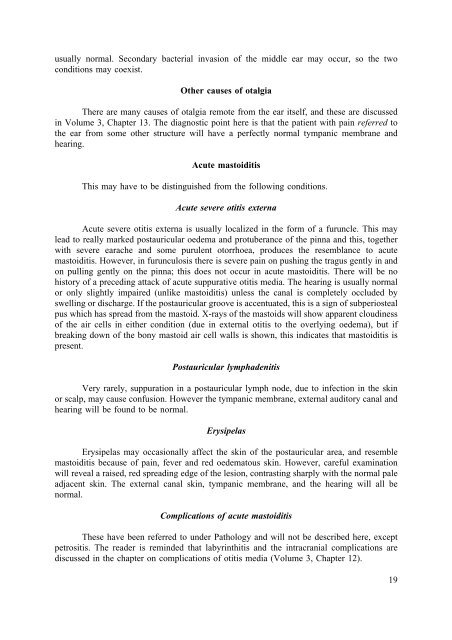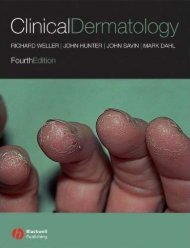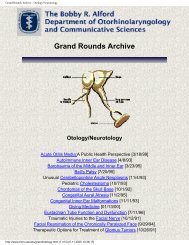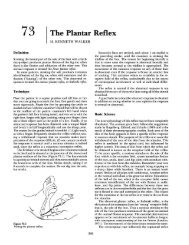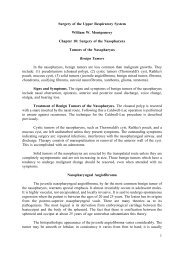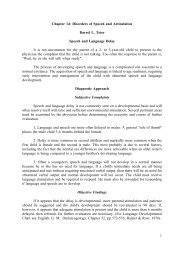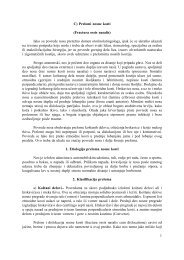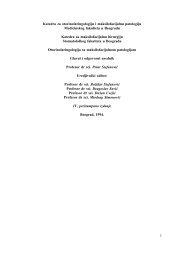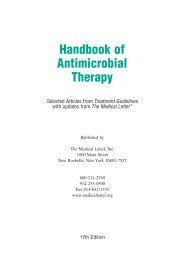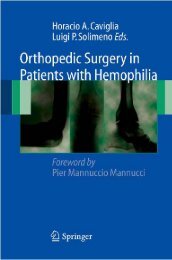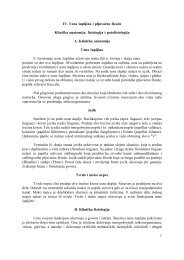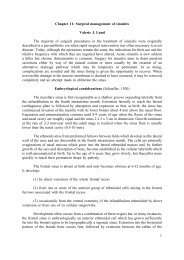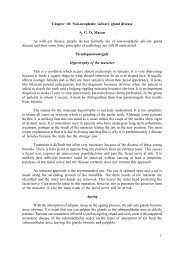1 Chapter 13: Acute suppurative otitis media and acute mastoiditis ...
1 Chapter 13: Acute suppurative otitis media and acute mastoiditis ...
1 Chapter 13: Acute suppurative otitis media and acute mastoiditis ...
You also want an ePaper? Increase the reach of your titles
YUMPU automatically turns print PDFs into web optimized ePapers that Google loves.
usually normal. Secondary bacterial invasion of the middle ear may occur, so the two<br />
conditions may coexist.<br />
Other causes of otalgia<br />
There are many causes of otalgia remote from the ear itself, <strong>and</strong> these are discussed<br />
in Volume 3, <strong>Chapter</strong> <strong>13</strong>. The diagnostic point here is that the patient with pain referred to<br />
the ear from some other structure will have a perfectly normal tympanic membrane <strong>and</strong><br />
hearing.<br />
<strong>Acute</strong> <strong>mastoiditis</strong><br />
This may have to be distinguished from the following conditions.<br />
<strong>Acute</strong> severe <strong>otitis</strong> externa<br />
<strong>Acute</strong> severe <strong>otitis</strong> externa is usually localized in the form of a furuncle. This may<br />
lead to really marked postauricular oedema <strong>and</strong> protuberance of the pinna <strong>and</strong> this, together<br />
with severe earache <strong>and</strong> some purulent otorrhoea, produces the resemblance to <strong>acute</strong><br />
<strong>mastoiditis</strong>. However, in furunculosis there is severe pain on pushing the tragus gently in <strong>and</strong><br />
on pulling gently on the pinna; this does not occur in <strong>acute</strong> <strong>mastoiditis</strong>. There will be no<br />
history of a preceding attack of <strong>acute</strong> <strong>suppurative</strong> <strong>otitis</strong> <strong>media</strong>. The hearing is usually normal<br />
or only slightly impaired (unlike <strong>mastoiditis</strong>) unless the canal is completely occluded by<br />
swelling or discharge. If the postauricular groove is accentuated, this is a sign of subperiosteal<br />
pus which has spread from the mastoid. X-rays of the mastoids will show apparent cloudiness<br />
of the air cells in either condition (due in external <strong>otitis</strong> to the overlying oedema), but if<br />
breaking down of the bony mastoid air cell walls is shown, this indicates that <strong>mastoiditis</strong> is<br />
present.<br />
Postauricular lymphadenitis<br />
Very rarely, suppuration in a postauricular lymph node, due to infection in the skin<br />
or scalp, may cause confusion. However the tympanic membrane, external auditory canal <strong>and</strong><br />
hearing will be found to be normal.<br />
Erysipelas<br />
Erysipelas may occasionally affect the skin of the postauricular area, <strong>and</strong> resemble<br />
<strong>mastoiditis</strong> because of pain, fever <strong>and</strong> red oedematous skin. However, careful examination<br />
will reveal a raised, red spreading edge of the lesion, contrasting sharply with the normal pale<br />
adjacent skin. The external canal skin, tympanic membrane, <strong>and</strong> the hearing will all be<br />
normal.<br />
Complications of <strong>acute</strong> <strong>mastoiditis</strong><br />
These have been referred to under Pathology <strong>and</strong> will not be described here, except<br />
petrositis. The reader is reminded that labyrinthitis <strong>and</strong> the intracranial complications are<br />
discussed in the chapter on complications of <strong>otitis</strong> <strong>media</strong> (Volume 3, <strong>Chapter</strong> 12).<br />
19


